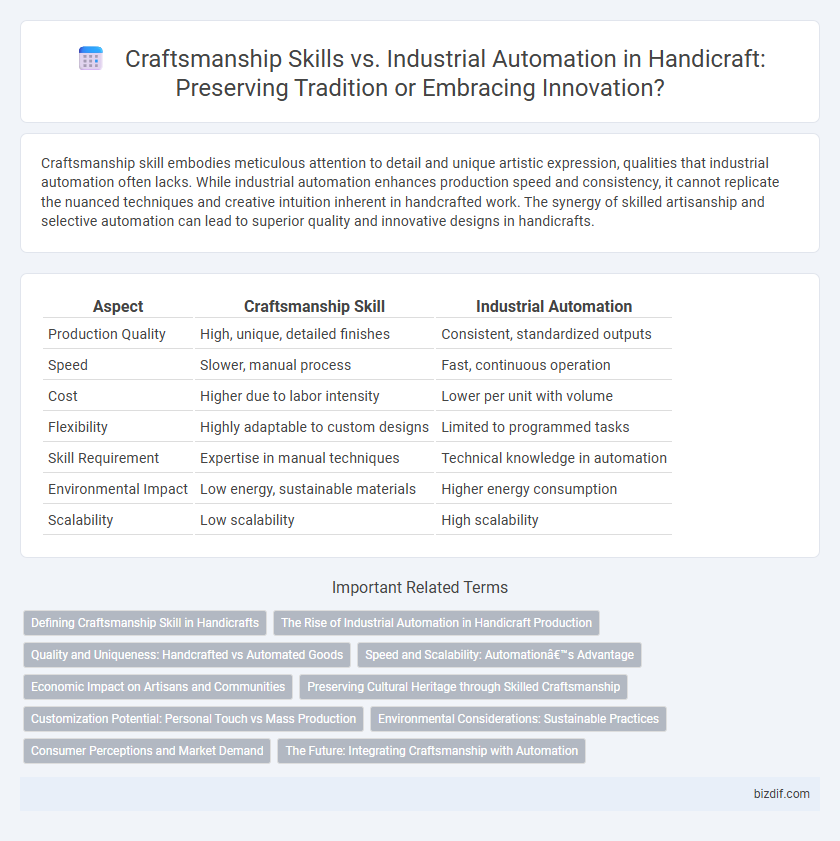Craftsmanship skill embodies meticulous attention to detail and unique artistic expression, qualities that industrial automation often lacks. While industrial automation enhances production speed and consistency, it cannot replicate the nuanced techniques and creative intuition inherent in handcrafted work. The synergy of skilled artisanship and selective automation can lead to superior quality and innovative designs in handicrafts.
Table of Comparison
| Aspect | Craftsmanship Skill | Industrial Automation |
|---|---|---|
| Production Quality | High, unique, detailed finishes | Consistent, standardized outputs |
| Speed | Slower, manual process | Fast, continuous operation |
| Cost | Higher due to labor intensity | Lower per unit with volume |
| Flexibility | Highly adaptable to custom designs | Limited to programmed tasks |
| Skill Requirement | Expertise in manual techniques | Technical knowledge in automation |
| Environmental Impact | Low energy, sustainable materials | Higher energy consumption |
| Scalability | Low scalability | High scalability |
Defining Craftsmanship Skill in Handicrafts
Craftsmanship skill in handicrafts embodies the mastery of traditional techniques, precision, and creativity developed through years of hands-on experience. Unlike industrial automation, which relies on machines for mass production, craftsmanship prioritizes uniqueness, quality, and the personal touch in each handmade item. This skill integrates deep knowledge of materials, tools, and cultural heritage, ensuring that every piece reflects authenticity and artistic expression.
The Rise of Industrial Automation in Handicraft Production
The rise of industrial automation in handicraft production has significantly transformed traditional craftsmanship by integrating advanced machinery and robotics to enhance precision and output. Automated systems streamline repetitive tasks, allowing artisans to focus on design innovation and quality control, thereby preserving the unique artistic value of handmade products. Despite technological advancements, the blend of skilled craftsmanship with automated processes creates a hybrid manufacturing approach that boosts efficiency while maintaining the authenticity of handcrafted goods.
Quality and Uniqueness: Handcrafted vs Automated Goods
Handcrafted goods demonstrate superior quality and uniqueness due to the artisan's meticulous attention to detail and personalized touch, which industrial automation often cannot replicate. While automated production excels in efficiency and uniformity, it typically sacrifices the nuanced artistry and bespoke characteristics inherent in handcrafted items. This distinction highlights the enduring value of craftsmanship in delivering products with exceptional individuality and intrinsic worth.
Speed and Scalability: Automation’s Advantage
Industrial automation significantly outperforms traditional craftsmanship in speed and scalability by enabling continuous, high-volume production with minimal human intervention. Automated systems streamline repetitive tasks and maintain consistent quality, allowing manufacturers to rapidly scale operations to meet growing demand. While craftsmanship excels in detail and uniqueness, automation's efficiency drives mass production and faster market delivery.
Economic Impact on Artisans and Communities
Craftsmanship skill preserves traditional techniques that generate unique, high-value products contributing significantly to local economies by supporting artisanal livelihoods. Industrial automation increases production efficiency but often displaces skilled artisans, leading to economic challenges and loss of cultural heritage in artisan communities. Balancing technology with craft preserves economic benefits for artisans while enabling scalability in global markets.
Preserving Cultural Heritage through Skilled Craftsmanship
Skilled craftsmanship preserves cultural heritage by maintaining traditional techniques that industrial automation cannot replicate, ensuring the authenticity and uniqueness of handmade handicrafts. Artisans' expertise enriches cultural identity, embedding historical narratives and regional aesthetics into each piece. While industrial automation maximizes production efficiency, the irreplaceable value of handcrafted items lies in their cultural significance and artistic expression.
Customization Potential: Personal Touch vs Mass Production
Craftsmanship skill offers unparalleled customization potential, allowing artisans to infuse each piece with a personal touch that reflects unique creativity and cultural heritage. Industrial automation excels in mass production by delivering consistent quality and minimizing costs, but often lacks the nuanced detail and individuality found in handcrafted items. The balance between these approaches highlights a trade-off where personal artistry meets efficiency and scalability.
Environmental Considerations: Sustainable Practices
Craftsmanship skill emphasizes sustainable practices by utilizing natural, biodegradable materials and minimizing waste through meticulous handcrafting techniques. Industrial automation often relies on mass production processes that generate higher energy consumption and increased carbon emissions, posing significant environmental challenges. Embracing traditional handicraft methods supports eco-friendly production, preserves cultural heritage, and promotes circular economy principles.
Consumer Perceptions and Market Demand
Consumers increasingly value the unique quality and authenticity associated with craftsmanship skill, perceiving handmade handicrafts as more valuable and culturally significant compared to mass-produced industrial goods. Market demand for artisanal products grows as buyers seek personalized, sustainable, and ethically made items that stand out in an automated production landscape. Industrial automation dominates in efficiency and volume, but craftsmanship sustains niche markets driven by consumer preference for originality and traditional techniques.
The Future: Integrating Craftsmanship with Automation
Craftsmanship skill embodies intricate manual techniques and artistic precision, offering unique, high-quality products that reflect cultural heritage. Industrial automation enhances production efficiency, consistency, and scalability through advanced robotics and AI-driven processes. The future of handicraft lies in integrating craftsmanship with automation, where smart technologies augment artisans' creativity and skill, enabling personalized, innovative designs while maintaining traditional excellence.
Craftsmanship skill vs Industrial automation Infographic

 bizdif.com
bizdif.com